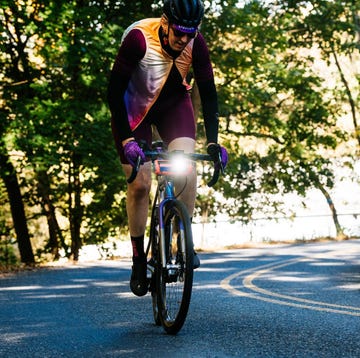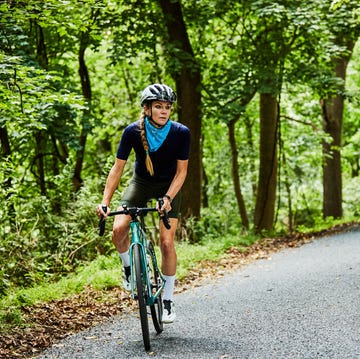If you’ve been working hard to get fit for a big event like a century ride, tapering is one of the best ways to optimize your performance come race day. Tapering is exactly what it sounds like—a gradual reduction in training volume leading up to your key event.
While you might be worried about losing all your fitness, without a solid taper, you’re actually not giving your body enough recovery to adapt to your training load.
“Tapering is a period of time where you’re reducing the volume of riding that you do in an effort to get a little bit of freshness so you can perform well at your century, fondo, or whatever you’re training for,” says Elizabeth Waterstraat, founder of Multisport Mastery, Inc., certified USA Triathlon Level II coach and Training Peaks-certified coach.
Backing off on training gives your body the chance to make physiological and psychological changes that set you up for better performance, says Waterstraat. Those changes include giving your body the energy to create new red blood cells. Red blood cells’ job is oxygen delivery, and the more effectively your body can deliver oxygen to your fatigued muscles, the more power you can generate before fatigue starts to slow you down. You might also notice you feel less tired and that you sleep better during your taper, which also supports better performance on race day, says Waterstraat.
But tapering isn’t for everyone or every race. You’re better off skipping a formal taper ahead of all but one or two A races, or if you haven’t trained enough to accumulate a significant amount of fatigue. For example, working parents who train a maximum of 10 hours per week may not benefit from tapering, says USAC-certified coach, Jennifer Sharp. Similarly, if you’ve been training for a month or less, you probably don’t need a taper, says Waterstraat.
If, on the other hand, you’re gearing up for a key event, and you’ve been consistently testing your limits in training for months, a taper is a great way to get the most out of your body on race day. For expert tips on how to execute your taper, keep reading.
How to Structure Your Taper
Each athlete’s taper will look different, depending on multiple factors, including how hard and how long you’ve been training, how your body has responded to tapering in the past, what you’re training for, your fitness level, and your life stressors.
Generally, though, a successful taper begins 10 days to three weeks before your A-race and involves maintaining intensity while shedding volume. “You want to go into your race prepared, but not tired,” says Sharp. Cutting the intensity out of your workouts in the days and weeks leading up to your big race can backfire and leave you feeling flat, she says.
Many cyclists benefit from beginning their taper by scaling back their weekday workouts by 15 to 30 minutes per session and shortening their long ride by 30 to 60 minutes, from week to week, while maintaining the same rhythm and frequency, says Waterstraat. So, if you typically do intervals on Tuesdays and Thursdays, recovery rides on Mondays and Wednesdays, and a long ride on Sunday, you’d maintain that structure while reducing the volume of each ride.
Resistance training during the taper can vary significantly from athlete to athlete, says Sharp. Generally though, she suggests continuing your core work but avoiding weightlifting beginning about two weeks to 10 days from your key race.
While the below guidelines will vary depending on the distance you’re riding, you can follow these suggestions if you’re prepping for an event like the century. (Most training plans will also have a taper built in, so make sure you follow the schedule!)
Three weeks out from race day:
Immediately before this period, you will have done your biggest training week, which could be anywhere from 10 to 12 hours, including a long ride of around six hours.
This week, you’ll continue to do your structured workouts and complete a long ride of about five to six-and-a-half hours while reducing your total training volume to about eight to 10 hours, depending on how you feel and the extent to which factors like sleep, work stress, family commitments, and travel are affecting you. Again, follow the structure above by reducing midweek workouts by 15 to 30 minutes and long rides by 30 to 60 minutes.
Two weeks out from race day:
As you did last week, continue to include interval training in your schedule on the same days as usual, complete a two-hour ride on the same day you’d normally do your long ride, and reduce your total volume to five to seven hours.
One week out from race day (race week):
Keep your interval sessions on the same days as usual, and make sure to include a day off two days before the race.
One day before the race, do a shakeout ride of up to one hour of mostly easy riding with a few short pick-ups. Your total training volume should be no more than three to four and a half hours (not including race day).
Do’s and Don’ts for Getting the Most of our Your Taper
Do Expect to Feel Les Than Amazing
“When you first start to taper it’s normal to feel pretty bad,” says Watersraat. “Your body has gotten accustomed to a certain routine and rhythm you’ve gotten into and now you’re changing it.” Common issues include lower energy levels, appetite changes, and mood issues, especially in the first three to seven days, she says.
It’s also not uncommon to feel better the next week as your body recovers, and then worse again in the days leading up to the event, says Waterstraat. But not to worry. “It’s actually a good sign not to feel great. I’ve personally found I’ve had some of my best races when I felt bad [in the days before it],” she says.
Do Take Time to Focus on Your Mindset
While you have extra hours back in your schedule, use some of that time to practice visualizing your ideal race day. Sharp suggests creating as vivid a mental picture as possible and incorporating all five senses as you go through every single part of the day, from eating your prerace breakfast to rolling up to the start line, to crossing the finish line.
Don’t Fill Your Calendar
“One of the biggest mistakes I see people making is using their taper to do housework or things that they put off [when their training volume was higher],” says Sharp. Instead of meeting up with friends or power-cleaning your garage, “take the space to truly rest,” says Waterstraat, who also cautions athletes against using the extra time in your schedule to overindulge in alcohol among friends.
Don’t Freak Out About Weight
“It’s normal to feel like you’re overeating relative to the reduced activity level, or like you’re getting puffy. But if you’re doing an endurance event, it’s important to show up rested and with some reserves,” says Waterstraat.
If you’re competing for three hours or longer, you need to carb load and make sure you’re hydrated, so if you gain a little weight, that’s okay, she says. In fact, Waterstraat suggests not looking at the scale, your Oura ring, or any other metrics that could distract you from the goal at hand in the week leading up to the race. “They matter before that, but not directly before the event,” and can unnecessarily shake your confidence, she says.
Don’t Experiment With New Recovery Techniques
During your taper you might be tempted to schedule massages, cold plunges, or the hot tub sessions you haven’t had time for. But if you’ve never tried these recovery techniques before, hold off until after your key race. “Trying something new right before a race could be a little disastrous,” and definitely not worth the risk, says Sharp.
Don’t Second-Guess Your Taper
After the first week of your taper, “the fog starts to clear and you start to feel fresh—and this is where people get into trouble,” says Waterstraat. Once you feel better, you might be tempted to do more than you should. “People ‘panic train’ because they’re worried about losing fitness,” says Waterstraat. Instead, stick with your plan and trust the process.

Pam Moore is an occupational therapist-turned-intuitive eating coach, certified personal trainer, and award-winning freelance writer with bylines in outlets including The Washington Post, Time, SELF, Outside, Runner's World, and others. Listen to her podcast, Real Fit, or subscribe to her newsletter, Real Nourished, at













